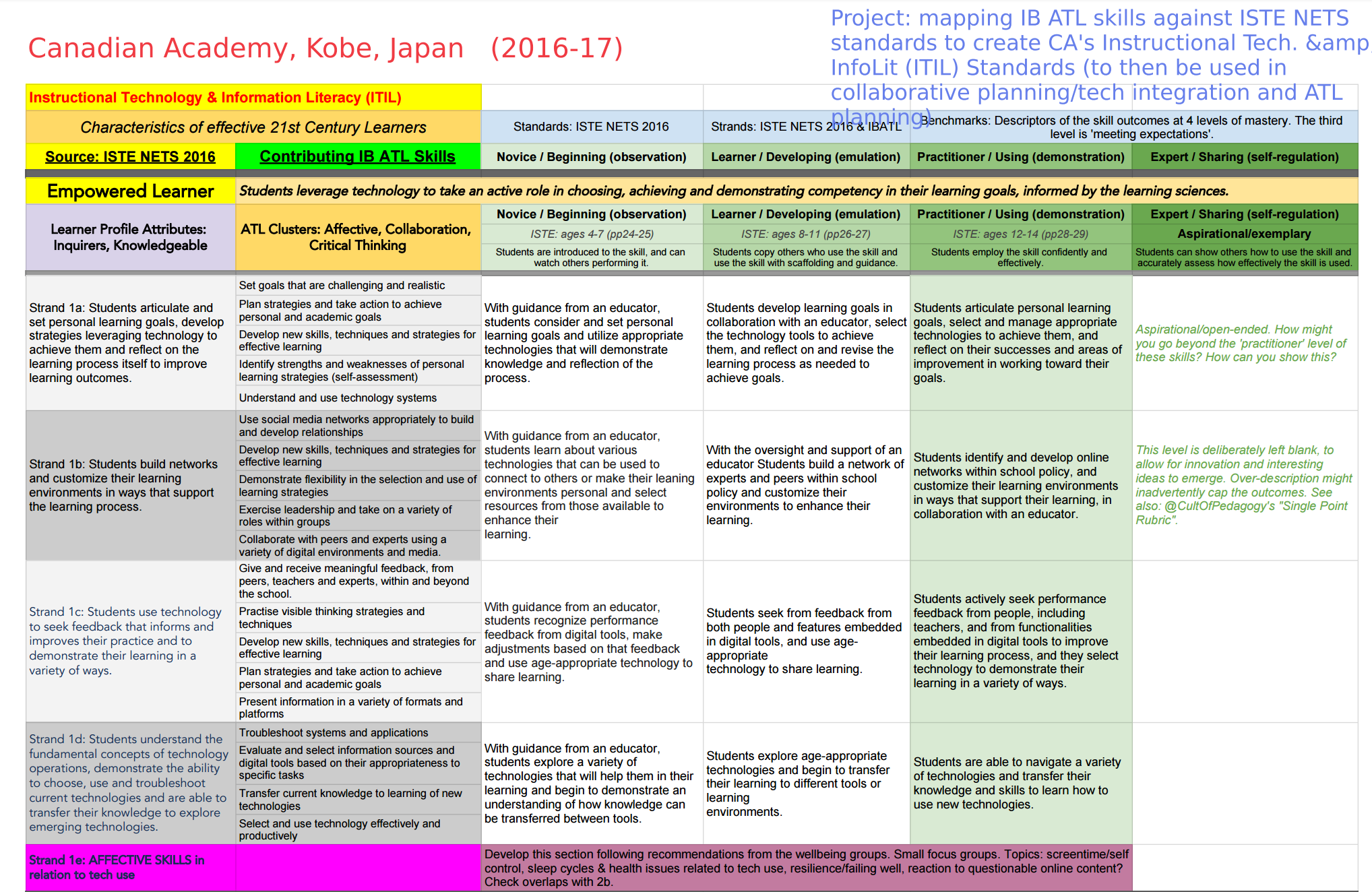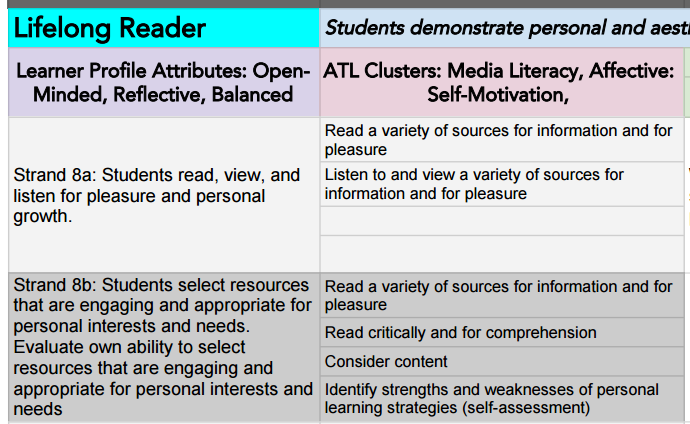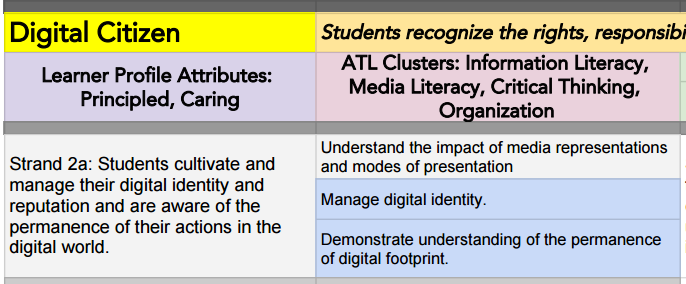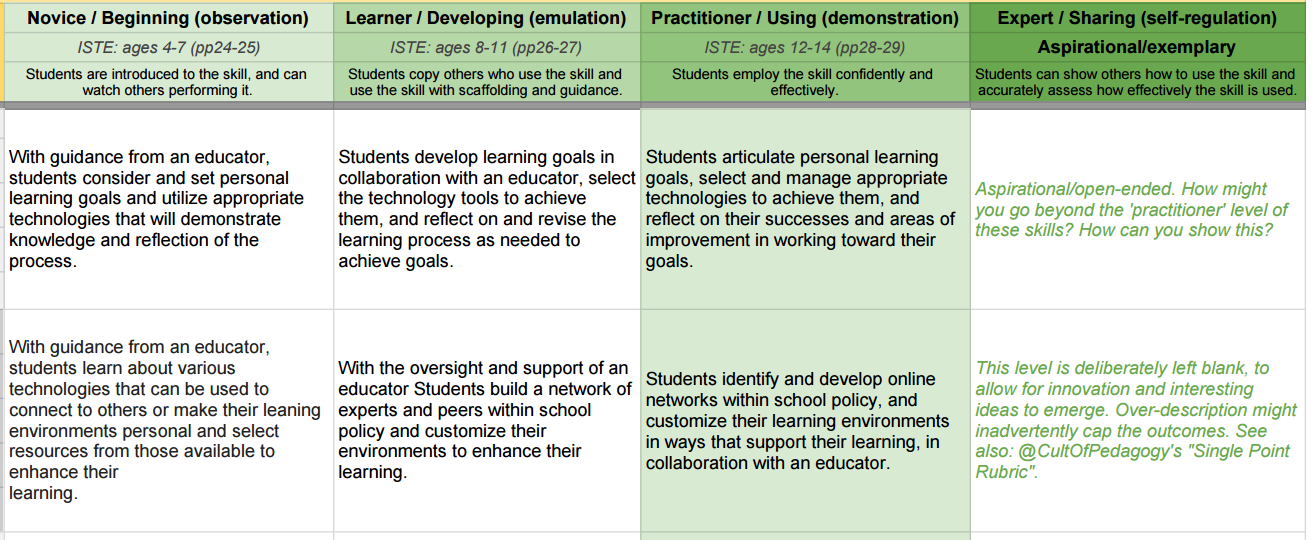Back in 2016-17, I worked with a group on a project to connect the IB ATL Skills to the ISTE Standards for Students and AASL Standards, to generate our own school’s Instructional Technology & Information Literacy (ITIL) Standards. CA is a three-programme IB school (PYP-MYP-DP). The goal was to create an alignment of the ISTE and ATL skills that would allow us to put the language of ATL first in conversation and collaborative planning with teachers, but to build on the excellent work and resources of ISTE in our co-planning and tech integration.
At the same time, it brought together a range of people responsible for working with teachers on their units of inquiry, and built a stronger connection through the library. This group included tech integrators, librarians and Liz Durkin (@lizdk), who along with being Associate Secondary Principal is now Ed Tech Director. I was in the role of MYP Coordinator and PK-12 Director of Learning. Planning took place in the library, and by the end of the 2016-17 year we had a framework to get started on, with some spaces for further development.
This post outlines some of the processes, decisions and next-steps for the project. This was a big project, starting almost two years ago, and I’m sure there will be parts I’ve forgotten, but now it’s the summer, there is some time to reflect and capture thoughts.

Decision 1: Keep the ISTE Standards but put ATL first with teachers
This fits in with a longer-term school-wide goal of better embedding the IB ATL skills framework in the school, and we were wary that adding another new set of language for teachers to use could create a block to implementation. We have kept the ISTE Standards and Strands as published, but unpacked each strand into a cluster of ATL skills that we saw as contributing to the realisation of the skill/strand.
Later on, ITIL co-planners as ‘gatekeepers’ of the ISTE standards would be able to articulate the connections. Also, as the IB MYP ATL skills framework was being developed in 2013-14(ish), it was clear that some skills were directly derived from 2007 ISTE NETS. With the 2016 ISTE for Students update, and seeing future directions of ATL in PYP and DP, we saw a timely opportunity to get to work.
Decision 2: Add a “Lifelong Reader” Standard
 This allowed for the stronger connection of the libraries as a research/ATL centre, but also made explicit the reading role of the library, referring to the AASL framework. The structure is the same, with standard, strands and ATL skills. We included, but are yet to develop (it’s in next year’s goals) a “mother tongue” strand to work out how the library can support ATL development through mother tongue and language acquisition support.
This allowed for the stronger connection of the libraries as a research/ATL centre, but also made explicit the reading role of the library, referring to the AASL framework. The structure is the same, with standard, strands and ATL skills. We included, but are yet to develop (it’s in next year’s goals) a “mother tongue” strand to work out how the library can support ATL development through mother tongue and language acquisition support.
Decision 3: Adapt for context
 As we went through the collaborative process of unpacking the ATL skills against the strands (first on paper, then on the spreadsheet), we spotted some opportunities to adapt to better suit our own context, or to generate custom ATL skill descriptors to better represent the meaning of the ISTE strand. We coloured these differently (blue in the example to the right), as a reminder that as specialist skills these are very unlikely to be covered in other classes and so will need to be found a ‘home’ in the curriculum.
As we went through the collaborative process of unpacking the ATL skills against the strands (first on paper, then on the spreadsheet), we spotted some opportunities to adapt to better suit our own context, or to generate custom ATL skill descriptors to better represent the meaning of the ISTE strand. We coloured these differently (blue in the example to the right), as a reminder that as specialist skills these are very unlikely to be covered in other classes and so will need to be found a ‘home’ in the curriculum.
Decision 4: Determine Descriptors
This was an attempt to align the four levels fo mastery of the ATL skills with the ISTE standards, to show our expectations of learners over time. We started with the third column (practitioner/demonstrating) as “meets expectations” and determined a statement of a competent student. Very quickly we realised the ISTE standards statements, with minor modification, fit the bill. We then developed band 2 (learner/developing) and band 1 descriptors (novice/beginning) as steps towards competence. Finally we decided to leave the fourth column blank and ‘aspirational’ as an opportunity for inventive and diverse high-level implementations to be opened up. After all, tech moves fast and we don’t want to cap creativity with artificial descriptors. See Cult of Pedagogy’s Single Point Rubric post for more discussion of this.

Decision 5: What skills do we need to know?
Although this project developed a strong connection between ISTE and ATL for the purposes of EdTech integration, we still needed to know what skills teachers and students need to know to be successful in our high-tech school. A supplementary process identified a “CA Tech Skills” inventory for orientation/support to help people get up and running successfully.
……….o0O0o………
Next steps & future development
This was a really enjoyable curriculum project and it worked well as a tool to bring co-planners and integrators from different sections of the school together. Next steps, of course, are to further implement the ISTE standards through embedding ATL into units and instruction via the library-tech and co-planners. Over the 2017-18 school year work began on this, and Liz Durkin expertly led the TALT & Tech Reps group in adopting the RAT model (replace, amplify, transform) of tech integration, identifying lots of amazing uses of tech in the school and spreading them through celebrating and sharing success. Over the next year, things will really click into place, including the work being done on digital wellbeing.
As I move on to a new role as learning/tech coach at another school, I look forward to continuing these discussions and collaborations.

Thank-you for your comments.